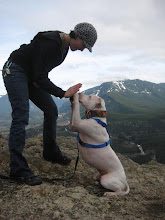Spring is here (ok, well, with the nice weather we had earlier this week it felt like it), and its time to dust off those paws and get back into training. For those of you teaching your pup a new trick or two, remembering the 3 D's of dog training will help ensure communication between you and your dog. The 3 D's are:
Distraction! Let's face it, if you learn your multiplication tables in a quiet class room, and are suddenly asked to perform in front of a noisy studio audience, you probably aren't going to do so hot. Distraction refers to all the sounds, sights, movement, smells and other exciting things in the environment that your dog is working in. All of these senses are adaptively significant to our dogs, so it behooves them to pay attention to their surroundings. When teaching your dog a new trick, start in a low distraction environment, such as your living room, that your dog is familiar with, that way he's able to better focus on you. Once you've got the desired behavior happening reliably about 85-90% of the time, then step it up. Remember, dogs are huge discriminators, so "sit pretty" in the living room doesn't automatically translate to "sit pretty" in the park. You have to generalize the cue by working on it in as many places as possible. Maybe start working in your backyard, next. Once you have success there, try the front yard. Then the side walk. Then maybe the sidewalk with another neighborhood dog walking by at a distance. Get the idea? You want to slowly increase his distraction level, but make sure he understands the cue in each context before moving forward.
Distance! Distance refers to the distance between you and your dog when you are asking for a behavior. If you've just taught your dog to "sit", and then walk 10 feet away and ask for him to sit, the chances of it happening are not too likely. Why? Because you've only taught him to sit with you directly in front of him. Now that you've moved 10 feet away, the whole scenario has changed. Just as with distraction, after your pup is responding to a cue reliably with you right next to him, slowly start to change it up. Try moving off to his left or right just a little. Turn your body slightly away from him. Take a few steps back. Remember, we need to generalize the cue, which means teaching Fido that "down" means "down" weather I'm facing him, turned away from him, bending over to tie my shoe, or 10 feet away. All of these are different pictures to your dog, so take it slowly and aim for success. Before ya know it, you'll have a rock solid command even if you are in another room of the house.
Duration! Duration refers to how long you are asking your dog to hold a position. If you're just beginning to teach your dog "stay", expecting him to stay for 5 minutes right off the bat is like asking a 6 year old to sit calmly through an insurance seminar. Your chances of success are slim to none. Start off asking for him to hold his "stay" for just 1 or 2 seconds, and slowly increase the time by 5 second increments. Try not to get greedy and go too fast, and if you notice your dog about to break position quickly reward him and tell him what a great dog he is before he has the chance to move. Set you dog up for success! The more reinforcement he gets for the desired behavior, and the less experiences he has with breaking his "stay", the less likely he will be to do so when you really need him to stay put. Duration is a really tough one for these social creatures, so take it easy on them!
One important caveat to the 3 D's : when you raise your citeria on one of the D's, drop your expectations for the other two. If you are working in a high distraction environment, lower your criteria for distance and duration. If you are working at a great distance from your dog, lower the environmental distractions and the duration of the behavior. Trying to raise all 3 at once can result in one confused dog, and a frustrated owner. So give your dog a little helping hand and only work on one "D" at a time. Set your dog up for success, and you can't loose!
Subscribe to:
Post Comments (Atom)

No comments:
Post a Comment